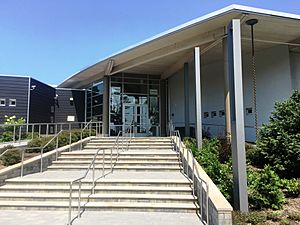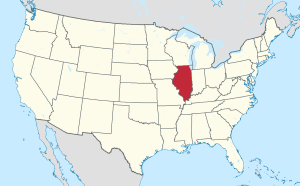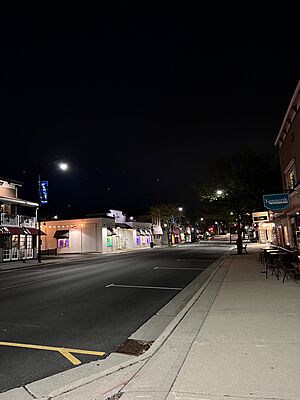Wauconda, Illinois facts for kids
Quick facts for kids
Wauconda, Illinois
|
||
|---|---|---|

Wauconda Area Library
|
||
|
||
| Motto(s):
"Water, Spirit, Wonder."
|
||

Location of Wauconda in Lake County, Illinois.
|
||

Location of Illinois in the United States
|
||
| Country | United States | |
| State | Illinois | |
| County | Lake | |
| Township | Wauconda | |
| Incorporated | 1872 | |
| Area | ||
| • Total | 5.76 sq mi (14.93 km2) | |
| • Land | 5.07 sq mi (13.14 km2) | |
| • Water | 0.69 sq mi (1.79 km2) | |
| Population
(2020)
|
||
| • Total | 14,084 | |
| • Density | 2,776.81/sq mi (1,072.05/km2) | |
| Time zone | UTC-6 (CST) | |
| • Summer (DST) | UTC-5 (CDT) | |
| ZIP Code(s) |
60084
|
|
| Area code(s) | 847 and 224 | |
| FIPS code | 17-79267 | |
| Wikimedia Commons | Wauconda, Illinois | |
Wauconda is a village in Lake County, Illinois. It's a suburb located northwest of Chicago. In 2020, about 14,084 people lived here. Wauconda is home to the Wauconda Bog Nature Preserve, a special place recognized as a National Natural Landmark. Kids from Pre-K to 12th grade in Wauconda and nearby towns like Island Lake, Lakemoor, and Volo go to schools in the Wauconda Community Unit School District 118. Some students from the northern part of Wauconda attend Fremont School District 79.
Contents
History of Wauconda
Early Days in the 1800s
Local stories say that Wauconda got its name from an old Native American chief. His name meant "spirit water."
Many of the first people to settle in Wauconda came from New England and New York. They traveled a long way, either by covered wagon or by boat through the Erie Canal and the Great Lakes.
In 1836, Elihu Hubbard built the very first log cabin near Bangs Lake. Later, in 1848, Justus Bangs, who was the first settler in Wauconda, built a house by the lake. The lake was then named after him.
Around 1840, members of the Winnebago tribe would visit the area to trade goods. In 1849, the people of Lake County voted to divide the county into towns, and Wauconda became an organized town. The first town meeting was held in April 1850, where the first leaders were chosen.
Wauconda's first school was built in 1839. The town's post office moved to Wauconda on June 27, 1849, and Hazard Green became the first postmaster.
Churches were also built early on. The first Baptist church was built in 1838. A Methodist church started in 1852 and was built in 1856. A Roman Catholic church was built in 1877.
By 1850, Wauconda had about 200 residents. It had three stores, two public houses, and various workshops. The Village of Wauconda officially became a village on August 18, 1877.
Wauconda in the 1900s
In the early 1900s, Wauconda became a popular vacation spot for people from Chicago. Bangs Lake was made ready for swimming and beaches. A railroad called the Palatine, Lake Zurich and Wauconda Railroad was finished. It carried farm products, mail, and people, including vacationers from Chicago. Even though the railroad didn't make Wauconda a big city, it helped the village grow as a resort.
The railroad stopped running in 1920 because not enough people were using it. Later in the 1920s, Phil's Beach opened, and the land for Route 176 (Liberty Street) was bought.
By the end of the 1930s, Wauconda's population was more than 500 people. By the late 1960s, Wauconda had three elementary schools, a junior high, and a high school. By the end of the 1970s, about 5,600 people lived in Wauconda.
During the 1980s, most of the beaches on Bangs Lake slowly closed. Houses, townhomes, and other buildings were built in their place. This building continued into the 1990s and 2000s as people from Chicago's outer suburbs looked for more affordable land. Many new neighborhoods were built north of the town center.
Wauconda in the 2000s
In 2000, Wauconda had 9,386 residents. By 2020, this number grew to 14,084 people.
In October 2019, the village finished a huge project to switch its water supply to Lake Michigan water. This was the biggest building project in the village's history, costing $48 million.
On April 4, 2023, the village held a vote about its "Home rule" status. The people voted to keep Wauconda from having home rule status.
Geography and Location
Wauconda is located at 42°16′1″N 88°8′34″W / 42.26694°N 88.14278°W.
According to the 2010 census, Wauconda covers about 5.73 square miles (14.84 square kilometers). Most of this area, about 5.05 square miles (13.08 square kilometers), is land. The rest, about 0.68 square miles (1.76 square kilometers), is water, mainly from Bangs Lake.
Getting Around Wauconda
Several important roads run through Wauconda. Route 12 goes north to south, and IL 176 goes west to east. IL 59 also helps connect the village to its surrounding areas.
If you need to fly, the closest international airport is O'Hare International Airport. It's about 30 miles away, which takes about 40 minutes to drive. Midway International Airport is a bit further, about 49 miles away, taking around 70 minutes to reach.
Population Changes in Wauconda
| Historical population | |||
|---|---|---|---|
| Census | Pop. | %± | |
| 1880 | 298 | — | |
| 1890 | 368 | 23.5% | |
| 1900 | 397 | 7.9% | |
| 1910 | 368 | −7.3% | |
| 1920 | 399 | 8.4% | |
| 1930 | 554 | 38.8% | |
| 1940 | 639 | 15.3% | |
| 1950 | 1,173 | 83.6% | |
| 1960 | 3,227 | 175.1% | |
| 1970 | 5,460 | 69.2% | |
| 1980 | 5,688 | 4.2% | |
| 1990 | 6,294 | 10.7% | |
| 2000 | 9,448 | 50.1% | |
| 2010 | 13,603 | 44.0% | |
| 2020 | 14,084 | 3.5% | |
| U.S. Decennial Census 2010 2020 |
|||
Wauconda's Population in 2020
The table below shows the different groups of people living in Wauconda, based on the 2020 census.
| Race / Ethnicity (NH = Non-Hispanic) | Pop 2000 | Pop 2010 | Pop 2020 | % 20200 | % 2010 | % 2020 |
|---|---|---|---|---|---|---|
| White alone (NH) | 8,047 | 10,317 | 9,981 | 85.17% | 78.84% | 70.87% |
| Black or African American alone (NH) | 38 | 107 | 155 | 0.40% | 0.79% | 1.10% |
| Native American or Alaska Native alone (NH) | 8 | 9 | 6 | 0.08% | 0.07% | 0.04% |
| Asian alone (NH) | 169 | 564 | 480 | 1.79% | 4.15% | 3.41% |
| Pacific Islander alone (NH) | 0 | 2 | 0 | 0.00% | 0.01% | 0.00% |
| Other race alone (NH) | 11 | 20 | 36 | 0.12% | 0.15% | 0.26% |
| Mixed race or Multiracial (NH) | 50 | 160 | 459 | 0.53% | 1.18% | 3.26% |
| Hispanic or Latino (any race) | 1,125 | 2,424 | 2,967 | 11.91% | 17.82% | 21.07% |
| Total | 9,448 | 13,603 | 14,084 | 100.00% | 100.00% | 100.00% |
Fun Events in Wauconda
Wauconda is known for some fun events!
- On January 28, 2005, over 2,900 people had a huge snowball fight. They set a new world record for the most people in a snowball fight!
- A weekly farmers market is held on Main Street every Thursday from July to September.
- Every June, a three-day carnival called Wauconda Fest takes place near the skate park and Wauconda High School.
- Many other events happen throughout the year. These include an annual expo in February at Wauconda High School, 4th of July fireworks on July 3, a Memorial Day parade, and outdoor movies.
See also
 In Spanish: Wauconda (Illinois) para niños
In Spanish: Wauconda (Illinois) para niños



